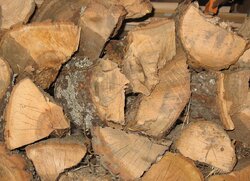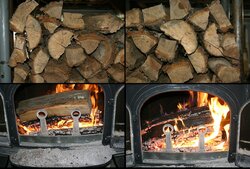Jack Straw said:
What do the other ends look like, you have to check both ends. I will admit that hickory tends to crack too soon. It does seem to work on most other wood. It sounds to me that you are rushing things a bit.
OK, that's easy enough since I have to walk past the far side on every trip to the stove. Different splits this time, about half of which are oak. First shot on left is the stove side, on the right is the far side. Not a huge difference between them because the
relative humidity in the room is about the same on both sides. Of course, the stove side gets a lot hotter, so there will be some difference, but as you can see, both hickory and oak are severely checked due to the harsh treatment I am giving them. You can also see several round indentations in some of the splits as well. These are from hitting the stack with a small sledge to get them to settle. It also allows me to bring in another one of my senses - hearing. You can definitely hear the wood get brighter and more resonant in tone as it dries over 2-3 weeks inside.
Adios is correct, the end checks don't tell you much. Wood dries from the end grain up to 15 times as fast as it does from the sides. When it dries very rapidly in extremely low RH conditions, the wood shrinks much faster at the ends than it does in the middle, and the grain is literally pulled apart on the ends because the middle is not shrinking much. Kiln operators keep the RH very high in the beginning of the cycle (near 100%) to reduce the chances of case-hardening and to keep end checking to a minimum. I want just the opposite - to destroy the grain on the end so the inside can dry along the multiple fissures that propagate from both ends. The effect is somewhat like splitting the wood into very thin splits, but still keeping it bound together so it won't burn fast like it would if all the splits were carried through the wood. In practice, the end checks appear after a very short time inside, but the actual drying takes a few weeks or more. I determine which ones go into the stove and when they go in simply by hefting them.
How well does this "system" that new burners aren't supposed to be hearing about actually work? Well, I grabbed one of the splits of oak (now 10 days inside instead of only three) and hefted it. Heft is not exactly the same thing as weight. Other tactile sensations are brought into play, and it is more a matter of feel than weight. Anyway, this one felt "right", so I plopped it down on top of three well involved splits (yup, all of them hickory from the same stack). The first photo is after a minute or so with the doors open. The second was taken seconds after I re-opened them, after about 5 minutes with the doors closed, bypass damper open and the intake air opened all the way. No smoke, sizzling or water coming out the ends. A good clean burn, leading to a nice hot stove in short order.
To address the original complaint of the OP, check out the doors and the back of my stove in the photos. Last night I loaded up the stove with big splits of that same hickory. I woke up to a cool stove with only a small bed of coals. The inside of the stove and all the latches were bone white, all indicating a real hot and clean overnight burn. When I started up the stove this morning, I used the very same hickory as the night before, except much smaller (and therefore drier) splits. But then I deliberately closed the bypass damper down prematurely and shut the intake air almost all the way to see what would happen. All of that black soot was created in about one hour of a smoldering burn. Which is what I think happened to basswidow, and not some errant damp piece of wood.
For the record, all of the information that I share on this site is intended to help new burners that are having problems with burning to understand
how wood burns, not to tell them how they should burn it in their own stoves. I only have experience with half a dozen stoves in my life. I don't sell them, repair them or collect them. But wood burns the same pretty much however you burn it, at least in a regular wood stove. I read all kinds of advice here that seems inaccurate to me, and at times just downright wacky (among the craziest is to go get some kiln-dried wood), but I try to keep an open mind and investigate what is said. 99% of the time I just keep my thoughts about these things to myself because I know that my experiences often run counter to the prevailing wisdom. My methods work for me just about 100% of the time, so that's all I really care about. I see nothing wrong with sharing my system/systems here if it will help a light come on inside some struggling person's head. I never once insisted that anybody follow my way. The assumption on my part is that folks will take everything posted here with a grain of salt and then figure it out on their own.





